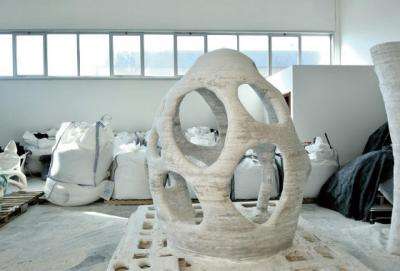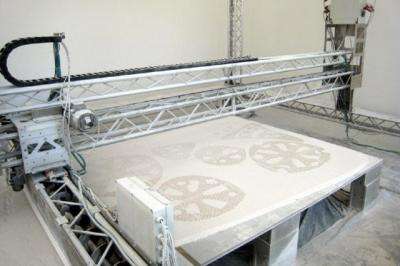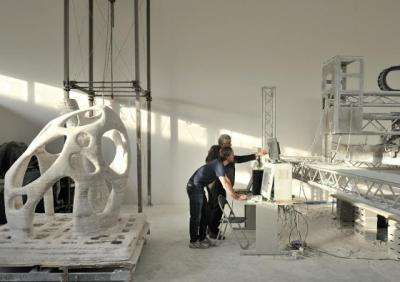April 19, 2010 weblog
3D printer could build moon bases

(PhysOrg.com) -- An Italian inventor, Enrico Dini, chairman of the company Monolite UK Ltd, has developed a huge three-dimensional printer called D-Shape that can print entire buildings out of sand and an inorganic binder. The printer works by spraying a thin layer of sand followed by a layer of magnesium-based binder from hundreds of nozzles on its underside. The glue turns the sand to solid stone, which is built up layer by layer from the bottom up to form a sculpture, or a sandstone building.
The D-shape printer can create a building four times faster than it could be built by conventional means, and reduces the cost to half or less. There is little waste, which is better for the environment, and it can easily “print” curved structures that are difficult and expensive to build by other means. Dini is proving the technology by creating a nine cubic meter pavilion for a roundabout in the town of Pontedera.
The printer can be moved along horizontal beams and four vertical columns, and the printer head is raised by only 5-10 mm for each new layer. The printer is driven by a computer running CAD software and prints at a resolution of 25 dpi (dots per inch). The completed material resembles marble, is stronger than concrete, and does not need iron reinforcing. The printing process can successfully create internal curves, partitions, ducting, and hollow columns.

Dini also has lunar plans for the D-shape, and is in discussions with La Scuola Normale Superiore, Norman Foster (a UK architecture firm), and Alta Space, as part of the Aurora program run by the European Space Agency (ESA), to build a modified D-Shape that could use lunar regolith (moon dust) to build a moon base. Dini will carry out trials in a vacuum chamber at Alta Space’s facility in Pisa to ensure the process is possible in a low-atmosphere environment such as the moon.
Dini said his ultimate dream is to complete Guidi's Sagrada Familia in Barcelona, which has been under construction since 1882 and which is not expected to be completed until 2026 at the earliest.

More information: D-shape: d-shape.com/
© 2010 PhysOrg.com


















